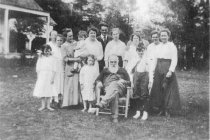Person Record
Metadata
Name |
Durgin, William Warren (1839-1929) |
Born |
Dec 18, 1839 |
Birthplace |
Stoneham, ME |
Places of Residence |
Stoneham, ME & Lovell |
Father |
Levi Durgin |
Mother |
Sallie Parker Durgin |
Notes |
At the time of his death, the oldest man in Lovell and the oldest Civil War Veteran. Buried at Gammon Cemetery in Stoneham, ME Vital Statistics shows date of death as Jan 27, 1929 Taken from the Spring 2014 Newsletter article written about Durgin by John and Liz McCann: "Headquarters 10th Regiment April 20, 1865 Veterans Reserve Corps Special Order Number 88 Pursuant to orders from Headquarters, 1st Brigade Veteran Reserve Corps requiring four First Sergeants should be selected with reference to their age, length of service and good soldierly conduct for escort duty to the remains of President Lincoln to Springfield, Illinois. 1st Sergeant William W. Durgin of Company F 10th Regiment V.R.C. is hereby detailed for that duty and will report to Capt. McCamly 9th Regiment Vet. Res. Corps at Camp Frye at 9:00 o’clock A.M. this day. By command of Major George Bowers Commanding Regiment Thus began the final military duty of one of Maine’s longest serving Civil War soldiers. Sgt William W. Durgin, late of Stoneham and soon to return to North Lovell, accompanied Abraham Lincoln’s body from that day until the fallen President was interred in his tomb in Springfield, Illinois. This journey traced in reverse the path the President had travelled en route to Washington DC upon his election four years earlier. During this two-week odyssey, the train travelled through 180 cities and 7 states. Along the way it is estimated that 1/3 of the population of the United States saw the train or passed by Lincoln’s coffin; more than 12 million people. It wouldn’t be until the advent of television that more people observed one single event. Sgt Durgin was with the President for the entire journey. His Civil War journey, though, began long before. On April 24th, 1861, 11 days after the fall of Ft. Sumter and the start of the Civil War, one of Durgin’s neighbors showed him the Waterford paper which said that Captain George Beal of Norway was organizing a company for Maine’s 1st Volunteer Regiment in Norway. Durgin and his friend walked the 20 miles to Norway and enlisted the next day. The 1st Maine Regiment never left Maine; like many of the original Civil War regiments it was called into service for only 90 days. The optimism that the war would be a quick one was soon dashed. Upon being released from service with the 1st Maine Regiment, Durgin promptly joined 9th Maine Infantry, an outfit with a three year term of service. Although the 9th Regiment was an army unit, they were used in support of a naval strategy to limit the South’s ability to receive supplies and support from abroad. Early in the war, the North was concerned that England would recognize the Confederacy and supply them with arms and other aid. While that never came to pass – England realizing that supporting a slave holding nation wouldn’t sit well with their own working class – the threat was real and even without official recognition many goods were smuggled into the South during the war. It was imperative that the North shut off, to whatever extent possible, the flow of materials into the South. In March 1862, the 9th Regiment was part of the 10th Army Corps and made one of the first amphibious landings in US military history when it went ashore in Fernadina, Florida to capture this important seaport. By seizing southern ports, the US Navy was able to base ships to patrol off shore and enforce the quarantine of the South. It must have been quite the culture shock to go from the mountains of western Maine to the Florida coast. The area was remote, swampy, and malarial. It’d be fun to visit Fernadina Beach today; in 1862 it would have been a misery. During his time in Fernadina, Sgt Durgin managed to have a cannon ball fall on his ankle. This seemingly minor injury worsened – in fact it bothered him to the end of his days – and in May 1863 he was discharged from the 9th Regiment and immediately joined the Invalid Corps. This Corps had been formed just the month prior and consisted of two classes of soldiers: partially disabled soldiers transferred to finish out their tour of duty; and disabled soldiers who wished to serve in some capacity but were no longer able to perform other than light military duty. Within a year, the name was changed to the more palatable Veteran Reserve Corps, which likely increased the number of soldiers interested in serving. Sgt Durgin soon became the 1st Sergeant of Company F of the 10th Regiment, V.R.C. The Regiment performed garrison duty in the fortifications around Washington DC, freeing up more able bodied soldiers to serve in the field. It was unglamorous work, but necessary and important to the war effort. When Durgin’s tour of duty expired in 1864, he re-enlisted for three more years. On the night of President Lincoln’s assassination on April 15th, 1865, he was at Camp Frye Barracks in Washington DC. He mustered with Company F for the funeral which was held four days later. As he later relayed: "My assignment to the Lincoln (funeral and) escort was of considerable surprise. I fell in with my company on the morning of the funeral and with them, along with thousands of other troops, marched down Pennsylvania Avenue and halted in front of the White House....While the Regiment waited in line, I heard a General asking a Colonel for a detail of men for the funeral. I heard the Colonel say "I guess this is the man for whom you are looking" referring to me. General Townsend detailed me to go into the White House with several men that had been selected. Once inside the White House I got the surprise of my life. General Townsend said, "You are to be one of the bearers." Here’s how another spectator described the scene inside the East Room of the White House that Sgt Durgin was soon part of: "About six hundred persons were admitted to the room, where the body lay, the head resting towards the north. From the entrance door at the northwest end of the room were placed the pall-bearers; next, the representatives of the Army; then the Judiciary; the Governors of the States; next, the Diplomatic Corps; the Judges of the Supreme Court; next, in the centre, and in front of the catafalque, stood the new President, Andrew Johnson." One imagines the surprise Sgt Durgin must have felt at being unexpectedly put into such an august gathering at the last minute, and given such a vital role. For the next 2 weeks, Sgt Durgin was in company with the body of the President and never more than a single rail car away from him. The official escort consisted of 25 sergeants (8 of whom, including Durgin, were the official pall bearers), eight generals and seven other officers. By order of the Secretary of War, there was never a moment through the entire journey when at least two members of the honor guard were not stationed alongside the President’s coffin. During the journey, there were twelve official stops, where Sgt Durgin and the other pall bearers carried the President’s casket from the train to a hearse, and then accompanied the body to and from a funeral service. He said later that "I had occasion to see the immortal remains many times. (Often) the casket was open, (and) there was also a sealed glass slide. President Lincoln looked as natural as he did in lifetime when I met him....In Springfield, my comrades and I carried the casket to its final resting place and placed it in the tomb." In addition to the official stops and the final internment, there were a multitude of spontaneous events that occurred along the path of the train. Bonfires, floral arches, hand painted signs, and masses of people marked nearly every mile of the route. People would stand in the rain for hours just to see the train pass by and pay their respects to the fallen President. As the author James Swanson notes, the train became about much more than just one man. "Somewhere between Washington and Springfield, the train became a universal symbol of the cost of the Civil War. It came to represent a mournful homecoming for all the lost men. In the heartbroken and collective judgment of the American people, an army of the dead – not just its commander in chief – rode aboard that train." One hopes as well that the sentiment the President expressed in his second Inaugural Address, delivered just the month before, travelled with him as well. "With malice toward none, with charity for all, with firmness in the right as God gives us to see the right, let us strive on to finish the work we are in, to bind up the nation’s wounds, to care for him who shall have borne the battle and for his widow and his orphan, to do all which may achieve and cherish a just and lasting peace among ourselves and with all nations." Discharged in November 1865, William Durgin returned to western Maine and settled in North Lovell where he worked as a spool maker before purchasing 40 acres to raise livestock and farm. He was justifiably proud of his service, wearing the Congressional Medal he received as a member of the honor guard whenever he appeared in public. He drew a Civil War pension for his injured ankle, and lived to the age of 90, the last surviving member of the honor guard which carried the fallen President with such respect and dignity from Washington to his final resting place in his hometown of Springfield. Sgt Durgin’s own grave in the North Stoneham cemetery is included in the national register of Civil War monuments. It reads: "One of Abraham Lincoln’s bearers and escort to Springfield Illinois. Helped to place Remains in tomb." |
Occupation |
Farmer |
Spouse |
Fannie E. (McKeen) - divorced |
Children |
Christie - died in infancy on Feb. 20, 1873 in Stoneham |
Deceased |
Jan 28, 1929 |
Deceased Where |
Lovell, ME |
Titles & honors |
Civil War soldier 1861 - 1865. One of eight men who acted as final escort for President Abraham Lincoln. |
Related Records
-

-
Boston Post Cane - 1974.02.0903
Information about the Boston Post Cane. Located in the file category "Events".
Record Type: Archive

-
Civil War, File 1 & 2 - 1974.02.0654
Two files of information on Lovell residents serving in the military during the Civil War. Located in the file category "Military".
Record Type: Archive

-
Deaths 1892-1939 - 1974.02.1342
Index and photocopy of Lovell's deaths from 1892 through 1939. Located in a notebook titled Births Deaths 1892-1939 Vital Statistics 1910-1945." A photocopy of the book can be found in the archival box "Lovell Vital Records Box 3."
Record Type: Archive

-
Durgin, William Warren - 1974.02.1013
Information on William Warren Durgin. Located in the file category "People".
Record Type: Archive

-
Five Generations of the Durgin Family - 2011.03.0023
Five generations of the Durgin family. From left to right: William Warren Durgin, W.E. Barker, Stella McKeen, Beryl Andrews, Donald Andrews. Taken from Photo CD #6. Used in the Spring 2014 Newsletter.
Record Type: Photo
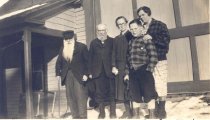
-
Gammon Family Reunion - 1925 - 2016.25.0024
Photo of the Gammon Family Reunion taken in 1925. Taken from Photo CD #12.
Record Type: Photo
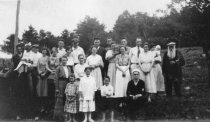
-
Headstone of William W. Durgin - 1983.04.0346
Two color photographs of the headstone of William W. Durgin. Used in the Spring 2014 Newsletter.
Record Type: Photo
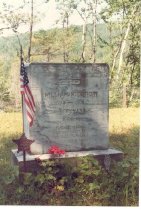
-
Obituaries - 1974.02.0692
Nine notebooks of obituary newsclippings, all indexed.
Record Type: Archive

-
Stone, Arthur P. - "William Warren Durgin" - 2004.11.0105
An essay written by Arthur Stone on William Warren Durgin. The original is located in Stone's Keewaydin Journal, Vol. I. Located in the file category "Manuscripts".
Record Type: Archive

-
Trostel, Scott D. - The Lincoln Funeral Train
The Final Journey and National Funeral for Abraham Lincoln
Record Type: Library

-
Veteran's Exhibit, Box 1 & 2 - 2001.20.0002
Material primarily gathered from the 2001 Veteran's Exhibit, later updated for the 2013 Honoring Our Veterans Exhibit. The material is housed in 2 10Hx15Wx12D archival record storage boxes. Contents of Box 1: Notebooks & Files Notebooks: Military Correspondence - Harold Thomson; Edward Bell; Harlan Rowe; Byron Emery; Milton Barker; Enfield Wilson; Edward Davey Jr.; Jimmy. Miscellaneous Military Information - David Thomson (WWII); Lucinda (Me...
Record Type: Archive

-
William Warren Durgin - 1983.02.0001
William Warren Durgin standing on his front steps with a rifle. Second copy donated by Evelyn and Gerald Davis. Used in the Spring 2014 Newsletter.
Record Type: Photo
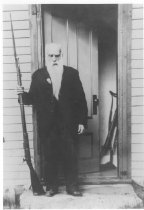
-
William Warren Durgin - 1983.02.0002
William Warren Durgin standing outside. Second copy by Evelyn & Gerald Davis.
Record Type: Photo
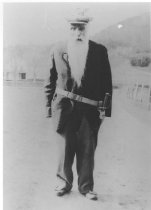
-
William Warren Durgin - 1998.02.0001
William Warren Durgin, a Civil War Veteran. He served as a member of VRG, accompanying Lincoln's body on the funeral train.
Record Type: Photo
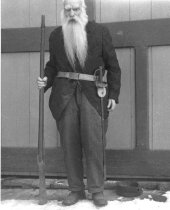
-
William Warren Durgin - 2015.49.0001
Two images from the Maine State Archives collection of William Warren Durgin. Accompanying the photos was the following description: "Late 1920s photographs from the Department of Economic Development, taken by photographer George French-of one of Maine's oldest surviving Civil War veterans, Sgt. William W. Durgin. Originally from Stoneham, Maine, Durgin was a member of the 1st Maine Regiment, the 9th Maine Volunteer Infantry, and the Invalid Cor...
Record Type: Photo
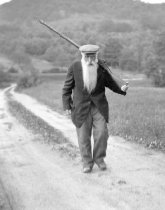
-
William Warren Durgin & Family - 2016.25.0005
Durgin family photo. Taken from Photo CD #12.
Record Type: Photo
